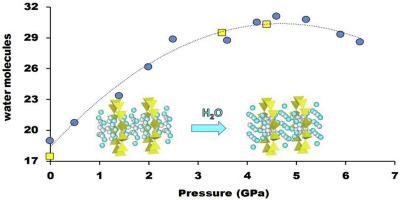Microporous and Mesoporous Materials ( IF 4.8 ) Pub Date : 2018-09-29 , DOI: 10.1016/j.micromeso.2018.09.031 Lara Gigli , Giovanna Vezzalini , Simona Quartieri , Rossella Arletti

|
This paper reports a study, performed by in-situ synchrotron X-ray powder diffraction, of the high-pressure behavior of zeolite L. The experiments were performed using both penetrating (methanol: ethanol: water mixture, m.e.w.) and non-penetrating (silicon oil, s.o.) pressure transmitting media (PTM) to study the compressibility and the possible pressure-induced hydration (PIH) of this synthetic zeolite, technologically relevant as host-guest system exploited in numerous application fields. The experiments were performed from Pamb to 6.2 and 6.3 GPa in s.o. and m.e.w., respectively. The crystal structure refinements were performed up to 6.3 GPa and 3.1 GPa for the patterns collected in m.e.w. and s.o., respectively, while the unit cell parameters were determined in the whole pressure range for both media. A strong PIH effect is evident when zeolite L is compressed in m.e.w. and the over-hydration is essentially ascribable to the filling of most the H2O sites, to the appearance of a new H2O site and to the partially filling of the K sites. The over-hydration starts at a very low pressure (0.5 GPa) and the maximum H2O content can be estimated in 31.1 H2O molecules, against the original value of 18. The PIH is completely reversible upon P release. The main difference between the compression behavior of zeolite L in the two media is the higher compressibility in the non-penetrating one, evidenced by ΔV = − 6.3% and −9.9% in m.e.w. and s.o, respectively. Our data are consistent with the general behavior of zeolites compressed with penetrating media, when the intrusion of H2O molecules hinders the effects of the applied pressure. The results of this work are compared with those obtained on a K-gallosilicate with LTL topology, where PIH induces the formation of H2O nanotubes inside the zeolite channel.
中文翻译:

沸石K
本文报道了通过原位同步加速器X射线粉末衍射对L型沸石的高压行为进行的研究。硅油等压力传递介质(PTM),以研究这种合成沸石的可压缩性和可能的压力诱导水合作用(PIH),该技术在许多应用领域中作为客用客用系统在技术上具有相关性。实验是从P amb进行的so和mew分别降至6.2和6.3 GPa。晶体结构的细化分别进行到6.3 gPa和3.1 GPa,分别收集在蜂等中,而晶胞参数是在两种介质的整个压力范围内确定的。当沸石L被压成片状时,PIH的作用很明显,而过度水化主要归因于大多数H 2 O位置的填充,新的H 2 O位置的出现以及K的部分填充。网站。过度水化在非常低的压力(0.5 GPa)处开始,并且可以在31.1 H 2 O分子中估计最大H 2 O含量,相对于原始值18。PIH在P时是完全可逆的释放。两种介质中沸石L的压缩行为之间的主要区别是非渗透性介质中的较高压缩性,分别以∆V = − 6.3%和-9.9%的摩尔当量证明。当H 2 O分子的侵入阻碍施加压力的影响时,我们的数据与用渗透介质压缩的沸石的一般行为是一致的。这项工作的结果与在具有LTL拓扑结构的K-镓硅酸盐上获得的结果进行了比较,PIH诱导了沸石通道内H 2 O纳米管的形成。











































 京公网安备 11010802027423号
京公网安备 11010802027423号